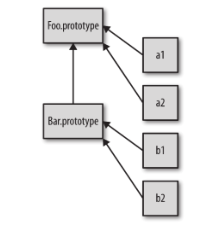你不知道的JavaScript(上)this和对象原型(四)原型
五章 原型
1、[[ Prototype ]]
JavaScript 中的对象有一个特殊的 [[Prototype]] 内置属性,其实就是对于其他对象的引用。几乎所有的对象在创建时 [[Prototype]] 属性都会被赋予一个非空的值。
对于默认的 [[Get]] 操作来说,如果无法在对象本身找到需要的属性,就会继续访问对象
的 [[Prototype]] 链:
1 var anotherObject = { 2 a:2 3 }; 4 // 创建一个关联到 anotherObject 的对象 5 var myObject = Object.create( anotherObject ); 6 myObject.a; // 2
还有另外一种方法,就是使用for..in遍历对象时原理,和查找[[ Prototype ]]链想死,任何可以通过原型链访问到的属性都会被枚举。使用in操作符来检查属性在对象中是否存在也会查找对象的整条原型链(无论属性是否可枚举)
var anotherObject = { a:2 }; // 创建一个关联到 anotherObject 的对象 var myObject = Object.create( anotherObject ); for (var k in myObject) { console.log("found: " + k); } // found: a ("a" in myObject); // true
2、“构造函数“
在 JavaScript 中对于“构造函数”最准确的解释是,所有带 new 的函数调用。函数不是构造函数,但是当且仅当使用 new 时,函数调用会变成“构造函数调用”。
1 function NothingSpecial() { 2 console.log( "Don't mind me!" ); 3 } 4 var a = new NothingSpecial(); 5 // "Don't mind me!" 6 a; // {}
3、原型继承【重点】

图中由下到上的箭头表明这是委托关联,不是复制操作。
典型的“原型风格”,例子如下:
1 function Foo(name) { 2 this.name = name; 3 } 4 Foo.prototype.myName = function() { 5 return this.name; 6 }; 7 function Bar(name,label) { 8 Foo.call( this, name ); 9 this.label = label; 10 } 11 // 我们创建了一个新的 Bar.prototype 对象并关联到 Foo.prototype 12 Bar.prototype = Object.create( Foo.prototype ); 13 // 注意!现在没有 Bar.prototype.constructor 了 14 // 如果你需要这个属性的话可能需要手动修复一下它 15 Bar.prototype.myLabel = function() { 16 return this.label; 17 }; 18 var a = new Bar( "a", "obj a" ); 19 a.myName(); // "a" 20 a.myLabel(); // "obj a"
核心部分就是语句 Bar.prototype = Object.create( Foo.prototype ) 。调用Object.create(..) 会凭空创建一个“新”对象并把新对象内部的 [[Prototype]] 关联到你指定的对象(本例中是 Foo.prototype )。但是 Object.create(..)唯一的缺点就是需要创建一个新对象然后把旧对象抛弃掉,不能直接修改已有的默认对象。
ES6添加了一个辅助函数Object.setPrototypeOf(..) ,可以用标准并且可靠的方法来修改关联。
对比一下两种关联的方法
1 // ES6 之前需要抛弃默认的 Bar.prototype 2 Bar.ptototype = Object.create( Foo.prototype ); 3 // ES6 开始可以直接修改现有的 Bar.prototype 4 Object.setPrototypeOf( Bar.prototype, Foo.prototype );
4、检查“类”的关系
寻找对象a委托的对象,也就是检查一个实例(js中的对象)的继承祖先(js中的委托关联)被称为内省(或者反射)
例子
1 function Foo() { 2 // ... 3 } 4 Foo.prototype.blah = ...; 5 var a = new Foo();
方法一 (instanceof)
instanceof 操作符的左操作数是一个普通的对象,右操作数是一个函数。 instanceof 回答的问题是:在 a 的整条 [[Prototype]] 链中是否有指向 Foo.prototype 的对象?可是,这个方法只能处理对象( a )和函数(带 .prototype 引用的 Foo )之间的关系。如果你想判断两个对象(比如 a 和 b )之间是否通过 [[Prototype]] 链关联,只用 instanceof无法实现
a instanceof Foo; // true
方法二
在本例中,我们实际上并不关心(甚至不需要) Foo ,我们只需要一个可以用来判断的对象(本例中是 Foo.prototype )就行。 isPrototypeOf(..) 回答的问题是:在 a 的整条 [[Prototype]] 链中是否出现过 Foo.prototype ?
Foo.prototype.isPrototypeOf( a ); // true
5、创建关联
Object.create() 的polyfill代码。这段 polyfill 代码使用了一个一次性函数 F ,我们通过改写它的 .prototype 属性使其指向想要关联的对象,然后再使用 new F() 来构造一个新对象进行关联。
1 if (!Object.create) { 2 Object.create = function(o) { 3 function F(){} 4 F.prototype = o; 5 return new F(); 6 }; 7 }
第六章 行为委托
重点:对象关联
1 Foo = { 2 init:function(who){ 3 this.me=who; 4 }, 5 identify:function(){ 6 return "i am "+this.me; 7 } 8 }; 9 Bar = Object.create(Foo); 10 Bar.speak = function(){ 11 console.log("hello"+this.identify()+"."); 12 } 13 var b1 = Object.create(Bar); 14 b1.init("b1"); 15 var b2 = Object.create(Bar); 16 b2.init("b2"); 17 b1.speak(); 18 b2.speak();
ES6 使用更好的对象字面形式的语法和简洁方法
1 var AuthController = { 2 errors: [], 3 checkAuth() { 4 // ... 5 }, 6 server(url,data) { 7 // ... 8 } 9 // ... 10 }; 11 // 现在把 AuthController 关联到 LoginController 12 Object.setPrototypeOf( AuthController, LoginController );






